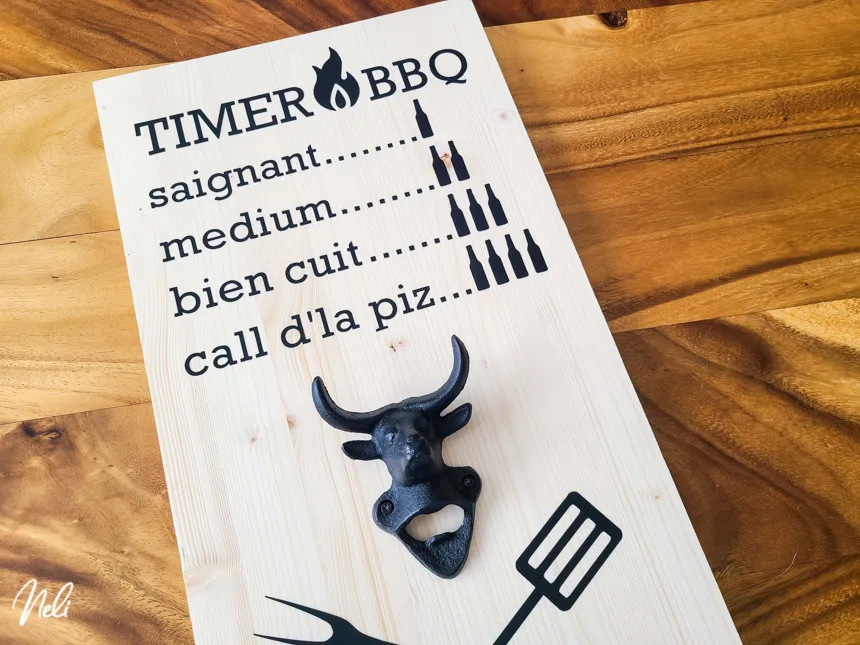When the time comes to embellish a wooden sign, we immediately think of adhesive vinyl. But do you know that it is possible to use heat transfer vinyl on wood?
In this post, I will explain the difference between the two techniques, under what conditions to use one or the other and even the pros and cons of using heat transfer vinyl on wood.

The difference between adhesive and heat transfer vinyl
First of all, it is important to understand the difference between adhesive vinyl and heat transfer vinyl.
Adhesive Vinyl
Adhesive vinyl is vinyl that has a backing to protect the back part of the vinyl where the glue is.
When we use this vinyl in the Cricut, it proceeds to cut the vinyl, without cutting this protective backing (we refer to this as a “kiss-cut”). We then remove the parts that we do not want (this is called weeding) to preserve only our design.
This vinyl can be applied to several hard surfaces and should ideally be transferred to these surfaces using transfer paper.
Heat transfer vinyl
Heat transfer vinyl is vinyl that requires heat to adhere to the blank. Cricut calls this material “Iron-On” and we also often hear HTV for Heat Transfer Vinyl.
This material is mainly used for fabric and requires a press (such as an iron, an EasyPress or an Autopress from Cricut) to make the transfer.
This vinyl is also on its own backing, but will not require transfer paper.
When loaded in the Cricut, it will also proceed to a “kiss-cut” to keep the backing intact. But it will be necessary to cut the image in “mirror” mode.
If you are confused, do not know how to differentiate these types of vinyl and are afraid of forgetting steps, download my free “No-mistake” cheat sheet below:
The pros of using heat transfer vinyl on wood
If heat transfer vinyl is made primarily for fabrics, then why use it on wood?
Here are some advantages of heat transfer vinyl, in my opinion:
- It’s thinner and more matte than adhesive vinyl. Its finish looks more like paint because it’s going to “melt” in the wood. As a matter of fact, it is better NOT to put varnish before, otherwise, the Iron-On will have nothing to “cling” to the wood;
- It is offered in many colours and styles (glitter, foil, etc.);
- It is way easier to weed;
- On the other hand, it is more expensive than adhesive vinyl except that if you add the price of the transfer paper that you must use with it, then the price becomes practically equivalent.
So, in summary, someone can save a lot of time by using heat transfer vinyl on wood.
The disadvantages of using heat transfer vinyl on wood
Obviously, who says “wood” says a surface that may not be perfectly flat.
Therefore, touch-ups will probably be required if the press plate does not touch perfectly the entire surface of the wood.
But warning! The other disadvantage is that you can’t heat too much! If the heat transfer vinyl is overheated, the glue will overflow and create a halo effect around the design.

When is it best to use adhesive vinyl on wood?
When using adhesive vinyl on wood, it is highly recommended to put a varnish BEFORE applying vinyl.
The glue of the vinyl will have difficulty adhering to the bare grain of the wood.
As mentioned above, for heat transfer vinyl, it’s the other way around. Heat transfer vinyl will have a lot of difficulties adhering to the wood if it is varnished or painted.
So, if you are thinking of putting your project outside, it is better to paint and varnish the wood and then use adhesive vinyl.
Do you need to add a coat of varnish AFTER applying the adhesive vinyl?
This is a controversial subject! Many factors come into play.
I can tell you that in my experience, adhesive vinyl does not need to be covered with an extra layer of varnish.
The only time I would tell you to do so is if your project is really very exposed to the elements of nature such as intense sun, snow, etc.
What if I put heat transfer vinyl and varnish the wood afterwards?
If you have already varnished wood, you may know that the recommendation is to sand between each layer of varnish because the varnish raises the grain of the wood.
So, if we apply the varnish after applying the heat transfer vinyl, the grain of the wood will rise, the varnish will seep under the vinyl and it will be impossible to sand without messing up the project.
What if I leave my heat transfer vinyl project without any wood finish outside?
It’s possible! My BBQ sign project (in french) will be my second test for you!
The first test I did, two years ago, was to put this design in full sun so that it undergoes all the elements, summer and winter.



After two years, the heat transfer vinyl is still very well in place. The wood grayed out, cracked, and the vinyl even “followed” the grain of the board.
The only downside: the vinyl yellowed a bit.
I can’t wait to see what the black heat transfer vinyl of my BBQ sign will do.

Psst, I’ve made an English version of the design of the “BBQ Timer” just for you! It’s available in my Cricut Access profile! You can also find it by following this link!

